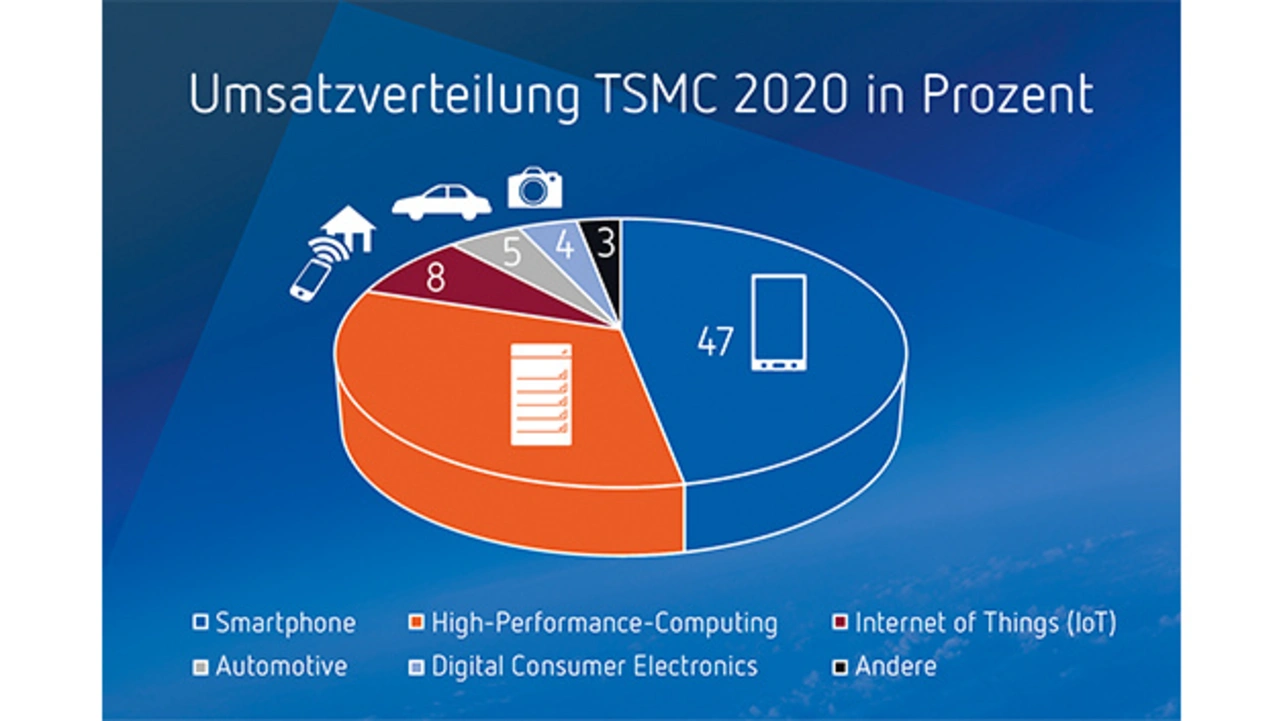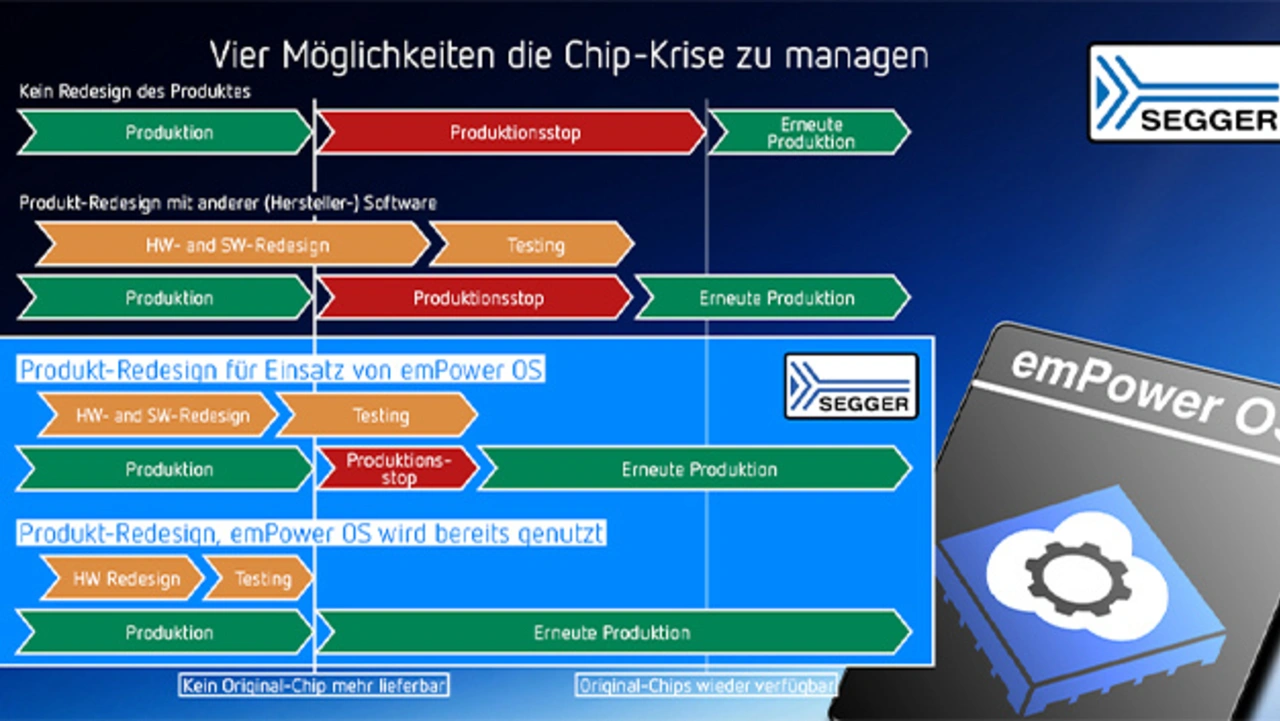Embedded systems design
Tips against the chip crisis and other risks
Manufacturers of embedded systems are currently suffering from delivery problems of large semiconductor manufacturers, the chip crisis. It also poses challenges for developers. In an interview, Johannes Lask, from Segger, explains how enterprises can manage the chip crisis and other risks.
Since assembly lines in the automotive industry came to a standstill, the chip crisis has also become a topic in the business press. However, in addition to the shortage of microprocessors, there are other risks for embedded system developers to consider. In an interview with Elektronik, Johannes Lask, product manager at Segger Microcontroller, responsible for the embedded operating system emPower OS, reveals what industrial companies can currently do. He points out risks and gives tips on how to become less sensitive to risks as a company.
? Even daily newspapers are reporting on the global chip shortage, which is shutting down the assembly lines of German automakers and leading to short-time work. What is the situation actually like for medium-sized companies?
! Johannes Lask: Even worse. We have a many small and medium-sized industrial companies as customers and see the effects directly. As a rule, the companies do not comment on this publicly because they do not want to be associated with the chip crisis and do not want to unsettle their customers. But of course, they have even less purchasing power with TSMC & Co. than, for example, an automotive Tier-1 or large consumer electronics manufacturer such as Apple or Samsung (Figure 1). Lead times stretching into 2022 for certain microcontrollers are unfortunately standard at present.

? What can a company do that can no longer get the microcontrollers it needs as usual?
! Lask: It really depends; you have to look at the market in a very differentiated way. For example: While certain Cortex M4 MCUs from a major European manufacturer are no longer available, alternatives from overseas are. However, the big question is: If I buy these chips now, will they help me in a timely manner?
Many industrial customers have succumbed to the temptation to use the free tools offered by the respective silicon vendors for software development. This is to tie customers to the manufacturers’ chips, making free choice in the market de facto impossible. Two examples: You cannot use the USB stack of one manufacturer for another device and changing from one limited RTOS to another is at least very complex.
? Segger calls its emPower OS an "all-in-one" embedded operating system. What's different there?
! Lask: Quite simply, emPower OS supports almost 1,000 microcontoller BSPs out-of-the-box and can be adapted to around 5,000 derivatives with minimal effort - no need to rewrite the customer application. We have customers who switched from one controller to another manufacturer's controller in 2 weeks. It took them only 2 weeks to redesign the controller board.
I can even name one customer explicitly, because we have already been able to help him twice: Carel Industries, a major supplier of high-end controllers, among other things, with annual sales of over 330 million euros and more than 1,700 employees, once had to switch from an MCU family that was not available to another MCU from the same manufacturer and then to a MCU from another manufacturer. This affected a product family that is experiencing extremely high growth in the market, so a production standstill would have been particularly painful.

In the diagram (Figure 2) we have summarized all alternatives in case of a supply stop of the microcontrollers used so far and the resulting duration of a potential production stop in each case. Doing nothing and sitting it out is of course the worst alternative. But companies already working with emPower OS today can switch over without any transition. Even developers who don’t work with emPower OS today will benefit from the fact that our RTOS offers all kinds of methods and objects for intertask communication, and makes a switch very easy.
Chip manufacturers like to partner with individual cloud providers to offer customers one-stop shopping, including cloud connectivity. However as with the chip, there is the dependency problem. Switching to another provider usually requires an unrealistic amount of effort to port the software, not to mention re-testing and debugging. The operating system emPower OS not only runs on thousands of microcontrollers It can also be connected to the services of all common cloud providers.
Although semiconductor manufacturers such as TSMC, Intel and Globalfoundries have announced massive investments in new capacities, these will not be available for at least 5 years. This will not help anyone in the short term. Unfortunately, for decades, politicians believed that semiconductors, like screws, were products that can be bought somewhere on the world market when needed - a disastrous mistake, but nobody wanted to heed the warning.
? Aside from the chip crisis, what other risks await embedded system developers?
! Lask: There are the product risks, which of course include price increases and legal changes or innovations, in addition to supply bottlenecks. There are also corporate risks which suppliers (chip manufacturers and software suppliers) shed light on as a company: How stable are they? Can their image have an impact on my company's reputation? Do they work sustainably with regards to the environment and society? Are they reliable? What about quality and willingness to innovate?
In addition, there are country risks. These relate to the financial stability of a country in the supply chain, compliance or corruption, and the observance of certain rights or regulations. This also includes the question of the impact of regional natural hazards or pandemics, as we unfortunately had to experience in the last 1.5 years. And as we have known since the blockade of the Suez Canal, there are also transport risks in the global supply chain.
? What do you see as the biggest risks at the corporate level?
! Lask: In recent years, there have been plenty of acquisitions in the semiconductor and software industries. The result is often the abandonment of "no longer strategic" business areas that may simply yield too low a margin. One example is the purchase of the formerly independent embedded software provider, Micrium, by the semiconductor manufacturer Silicon Labs. Their primary and understandable interest is, of course, to sell and support its own chips and not those of STMicroelectronics, NXP, Renesas or Microchip.

In the case of development environments and embedded software libraries, some questions arise: Is it possible with this license to migrate from one product to another in the event of insolvency or takeover, or to continue working with the licensed product? If this is possible, how difficult is it? What resources are needed, and is it possible to develop it further yourself? For example: In a license subscription model, the customer does not formally own the software. If the vendor no longer exists, there is often no way to continue the software.
Another example is software license management, where some vendors work with hardware locks (dongles) or network licenses. In the latter case, the administrative effort involved in determining which employee is allowed to work with which license and when should not be disregarded: A broken dongle means that work comes to a standstill for the time being. And then there is the question of software quality. An evaluation version without full functionality means that you can't evaluate parts of the software. Instead, you must rely on the vendor's promise that these unreleased parts meet the required quality standards.
? What do low-risk licensing terms look like to you?
! Lask: Segger’s licensing model for emPower OS is simple and risk-free for the customer: All components are delivered in source code, which allows full transparency and portability. There are no opaque libraries. Under Segger's commercial licensing, our software is royalty-free. This means that each license purchased is a one-time payment, making the software part of the equipment cost. This cost is static. For training and evaluation purposes, the use of the object code libraries is free of charge. So the customer can test the full functionality before licensing the software. In addition, they get one year of free support and updates after the purchase.
? Does the license allow your customers to protect their code or do they have to disclose the source code of their own developments, as is the case with open source software with copyleft usage licenses such as the GPL?
! Lask: No, emPower OS is not covered by a viral or copyleft license, so there is no threat of litigation with the FSF or other copyright holders for non-compliance that would potentially force disclosure of our customers' source code.
? A few years ago, the U.S. government's "Entity List" gained notoriety, a kind of blacklist on which mainly Chinese companies are listed. What should companies pay attention to?
! Lask: The effects are drastic: Not only do U.S. companies need a special license to supply the listed companies with their products, but a license is also required to supply products that contain intellectual property or components from U.S. companies or were developed in the United States.
Buyers of hardware and software components from suppliers should therefore ensure that these components can be incorporated without the end product developed with them being affected by export restrictions. Since emPower OS is developed in Western Europe, it is not subject to US export restrictions and does not contain any code developed in the USA.
? In many companies, price is the most important decision criterion. What is the "price" of the risks mentioned?
! Lask: If one or more of the above-mentioned risks materialize, your calculation will fail because it will be expensive. In a risk management seminar, you learn in the first hour how to evaluate risks economically: Risk in dollars equals the potential loss multiplied by the probability of occurrence. The industry is currently losing billions of dollars due to production downtimes because of the chip crisis, so what's the use of saving a few cents on the microcontroller and comparatively little investment in software up to now?
You also don't usually get any support for the free software offered by chip manufacturers. Normally you must hire external consulting companies for this, which you of course have to pay: For both the initial setup and also for the changeover.

Also relevant for effective software product costs are questions such as whether and to what extent a provider is prepared to work with individual customers at all, when there is a need to adapt its software and what support is offered. This especially applies if software components are purchased from several suppliers which must then work together optimally, because an "out-of-the-box" experience will hardly be possible in such cases. For example: An RTOS from supplier A, an IP stack from supplier B, a crypto and security module from supplier C will require a more or less manual adaptation effort. If the customer is Apple, vendor support is likely to be forthcoming, but what about small or medium-sized enterprises which are more numerous?
? Let's get back to emPower OS, the "all-in-one" embedded operating system as you call it. What does it consist of exactly?
! Lask: The operation system emPower OS provides all the components a software developer needs to develop embedded applications. This includes a real-time operating system, wired and wireless connectivity, graphical user interface design, data compression, and secure cloud connectivity. There is no need to integrate third-party software, which reduces the risks and costs of the development process. In addition, emPower OS is supported and continuously improved and enhanced by Segger engineers. Segger developers are also happy to work with individual customers to find a solution even for exotic hardware. Together with our IDE Embedded Studio and our J-Link debuggers, we offer a one-stop solution for embedded developers.
? Mr. Lask, thank you very much for your time.
Literature
[1] emPower OS – The High-Performance Software Platform. Segger Microcontroller, Website, www.segger.com/products/empoweros.
[2] Kinzler, P.; et al.: Lieferanten-Risikomanagement in der deutschen Automobilindustrie 2020. Deloitte, Mai 2020, www2.deloitte.com/content/dam/Deloitte/de/Documents/finance/Supplier_risk_management_Studie_2020.pdf







